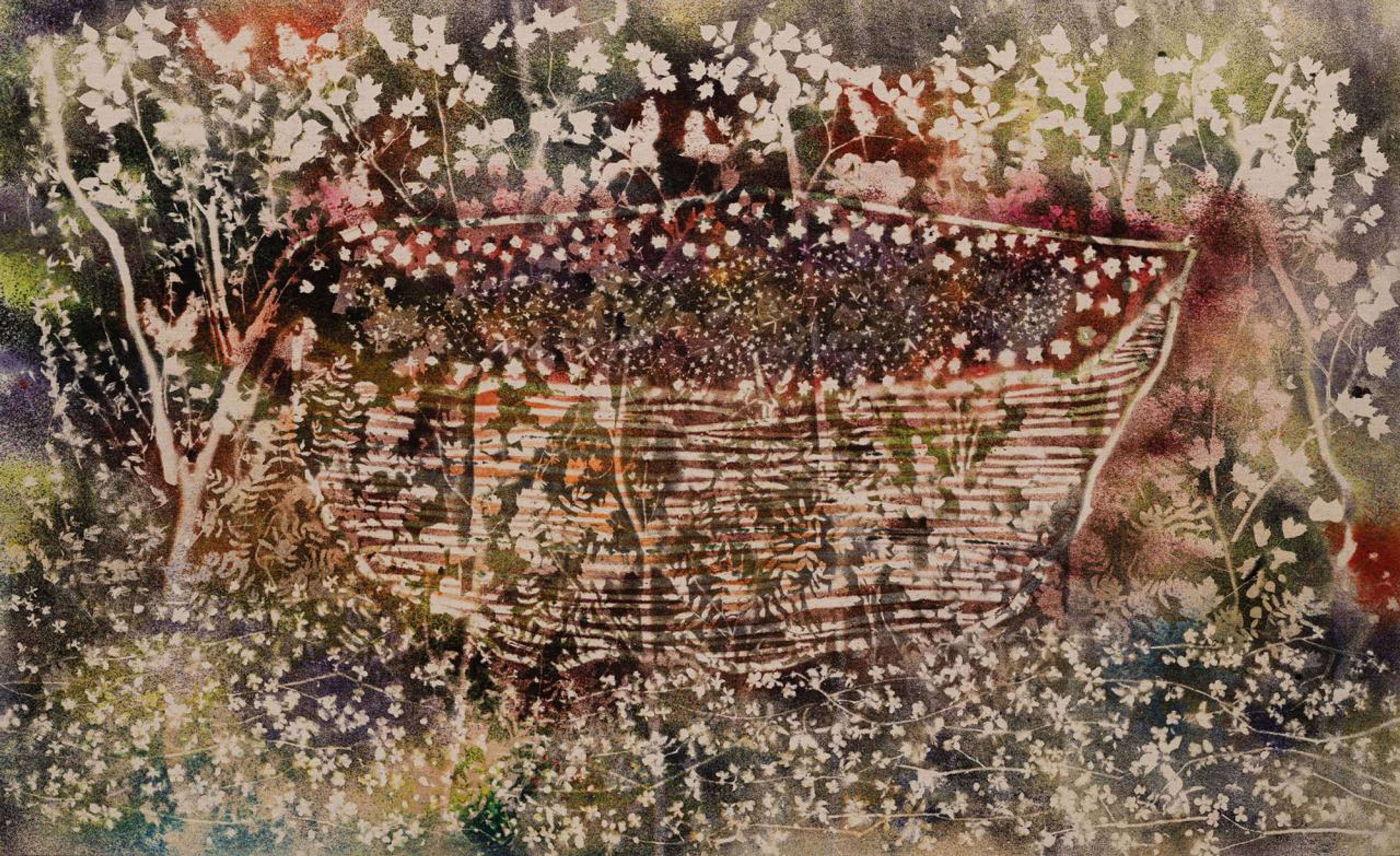Let’s take a walk in the woods, gamboling through the peat moss, creeks, rocks, and craggy terrain. As we meander here and there, the sun cuts a radiant beam straight down towards the loamy earth, like a glowing furnace faceted off the auriferous rocks and quartz veins. Photosynthesis is at play. Plant forms grow upward, filled with the splendor of an unfolding process rich in nutrients and bursting with the colors of nature. We revel in the Edenic display and the muffled sounds of the rustic foliage. Its living inhabitants console our primal need for solitude, contemplation, and the untrammeled grace of the natural order.
Taking cover on a raw, blustery winter afternoon, I step inside the warm confines of Galerie Eva Presenhuber, Vienna, to enter the world of Sam Falls (*1984) and his botanical memento mori. Here, in a contemporary vernacular, and inside a rather austere, difficult architectural space, thirteen mostly large-format, hushed, mixed-media works (all works 2022) create the feeling of entering a soundproof room. This quietude is a shock to the system, for the artist captures the faculties of natural forces out of time. That the delicate pictures are made on canvas, lace, and silk makes them outliers to the formulaic abstractions, social realist figuration, and Ballardian, neo sci-fi, gothic painting of the moment. Yet paintings they are not.
Sam Falls, Charon, 2022, pigment on canvas, 140 x 140 cm
Conceptually, Falls has developed a material language of the rudimentary (natural pigments, twigs, foliage, clay) in order to concretize universal truths about the transient. The works are “made” in the great outdoors and closely bound together by a common idea, yet he lets each follow its destiny separately. The natural world holds sway. Here are the gaps between man and nature, art and life.
For what is the power that animates sensory perception? Be glad for it, as we cross thresholds. Pantone recently announced that its color of the year for 2023 is a synthetic magenta partly derived from the metaverse. Choose your world. Perhaps you’d like to mount the boat in the work titled Charon , named for the wizened old man who ferries souls across the rivers Styx and Acheron to the underworld, Hades, a realm beyond the earthly boundaries of time and place. Falls uses twigs to form an unwieldly, skeletal boat, surrounded by blots of embedded pigment and the negative imprint of foliage.
Sam Falls, Devil/Angel, 2022, pigment on canvas, 201 x 229 x 3 cm
Bookending this particular work, Devil/Angel and Angel/Devil allude to the twin poles of the human psyche, their figures likewise produced using fine twigs that recall the arterial and venous structures within the human body, rather than meaty corporeality. Among the thirteen works exhibited, Angel/Devil , with its thin, mustard-plant stalks, is the apotheosis of Falls’s modus operandi, where Mallarméan chance and luck meet. Its richness can be neither understated nor translated into flat, digital reproductions.
In fact, Falls’s highly refined craft is evident, geared towards decorative art. Take the marvelous, wall-mounted ceramic work Fossils , where a Fujifilm instant photo inserted into the middle of the ceramic is a literal window to a world within a world. A field of dried flowers and pigments is sealed into the fired clay, framing a photographic field of flowers. This nexus of two- and three-dimensional media holds its own in a location surrounded by Vienna’s baroque edifices and the decorative arts of another epoch.
Sam Falls, Angel/Devil, 2022, pigment on canvas, 201 x 219 x 3 cm
The peripatetic Falls has at different times lived along and between the western and eastern seaboards of the United States and has exhibited widely in Europe. Like a high plains drifter, he knows his geographic terrain. As a Vermonter, he’s experienced the ravishing autumnal display wherein, due to the particular chemical composition of the state’s rocky soil, an especially dramatic, natural coloration occurs: from deep greens to chartreuse, through rich plum reds, yellow ochres, and rusty oranges; then a final burst of colorful translucence, before falling away to dry and decompose into the dusty earth.
As old frontiers disappear in science and art, we look for a new place to hang our hat, to get a tangible sense of being, to make things whole again. To understand Falls, one ought to view him in the tradition of 19th-century American transcendentalism. While dealing with 21st-century issues, his art is contiguous with Emerson’s essay “Nature” (1836), Thoreau’s Walden: Or, Life in the Woods (1854), and Walt Whitman’s Leaves of Grass (1855), as well as, closer to our own era, the work of Pacific Northwest artists like Morris Graves, who was influenced by eastern mysticism and Neoplatonic philosophy. One has to look through the organism of Falls’s viewfinder in monastic silence and turn off all the extraneous noise. Cynics will note the child-like way in which the compositions are made, yet in real space and real time, there is nothing childish about them. Only the echoes of the hummingbirds, daffodils, hyacinths, and ferns remain.
Sam Falls, Fossils, 2022, Fujifilm FP-100c45, glazed ceramic with fused glass, 32.5 x 24.5 x 5.5 cm
___
Sam Falls
Galerie Eva Presenhuber, Vienna
5 Nov – 22 Dec 2022






